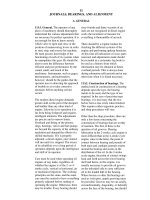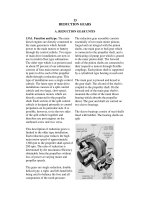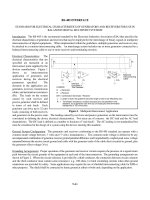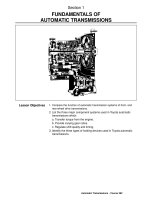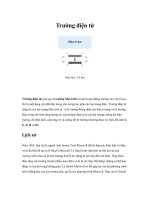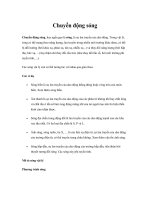Tài liệu Malvino-EP-02- Bán dẫn pptx
Bạn đang xem bản rút gọn của tài liệu. Xem và tải ngay bản đầy đủ của tài liệu tại đây (401.12 KB, 30 trang )
Chương 2
Chương
2
Bán dẫn
Bán
dẫn
Từ Vựng (1)
Từ
Vựng
(1)
•
ambient temperature=nhiệt độ xung quanh
ambient
temperature=nhiệt
độ
xung
quanh
• avalanche effect=hiệu ứng đánh thủng
bi ttil àthế
•
b
arr
i
er po
t
en
ti
a
l
= r
à
o
thế
• breakdown voltage=điện áp đánh thủng
• conduction band= dãy dẫn
•
depletion layer
=
miền nghèo (hạtdẫntự
depletion
layer miền
nghèo
(hạt
dẫn
tự
do)
•
diode
•
diode
• Doping = pha tạp chất
Từ Vựng (2)
Từ
Vựng
(2)
•
forward bias
=
phân cựcthuận
forward
bias
phân
cực
thuận
• free electron = điện tử tự do
•
Hole = lỗ (trống)
•
Hole
=
lỗ
(trống)
• junction diode = diode tiếp xúc
jtit t hiệt độ tiế ú
•
j
unc
ti
on
t
empera
t
ure = n
hiệt
độ
tiế
p x
ú
c
• majority carriers = các hạt dẫn đa số
ẫ ể ố
• minority carriers = các hạt d
ẫ
n thi
ể
u s
ố
• n-type semiconductor = bán dẫn loại N
Từ Vựng (3)
Từ
Vựng
(3)
•
p
-
type semiconductor
=
bán dẫnloạiP
p
type
semiconductor
bán
dẫn
loại
P
• pn junction = tiếp xúc PN
•
Recombination = tái hợp
•
Recombination
=
tái
hợp
• reverse bias = phân cực ngược
Si dt bádẫ
•
S
em
i
con
d
uc
t
or =
bá
n
dẫ
n
• Silicon
ề
• surface-leakage current = dòng rò b
ề
mặt
• thermal energy = nhiệt năng
Nội dung chương 2
Nội
dung
chương
2
2-1 Vật dẫn điện
ẫ
2-2 Bán d
ẫ
n
2-3 Tinh thể Silic
2-4 Bán dẫn nội tại (bán dẫn thuần)
2-5 Hai loại dòng (hạt dẫn)
2-6 Pha tạp chất vào bán dẫn
2-7 Hai loại bán dẫn n
g
oại lai
(
có
p
ha tạ
p
chất
)
g (p p )
2-8 Diode chưa phân cực
2-9 Phân cực thuận
2-10 Phân c
ự
c n
g
ư
ợ
c
ự g ợ
2-11 Đánh thủng
2-12 Các mức năng lượng
2-1
3
Đồ
i n
ă
n
g
l
ượ
n
g
3
ồ ă g ượ g
2-14 Rào thế và nhiệt độ
2-15 Diode phân cực ngược
2
-
1Vậtdẫn điện
2
1
Vật
dẫn
điện
•
Các
vậtdẫn điện
tốtnhấtlàbạc đồng và
Các
vật
dẫn
điện
tốt
nhất
là
bạc
,
đồng
và
vàng.
•
Quỹ đạo ổn định
•
Quỹ
đạo
ổn
định
• Điện tử hóa trị: điện tử ở lớp ngoài cùng
têtử
t
rong nguy
ê
n
tử
• Điện tử tự do dễ dàng sinh ra trong vật
dẫn điện
Đồng
Đồng
2
-
2Bándẫn
2
2
Bán
dẫn
•
Bán dẫncótínhchất điệngiữachấtdẫn
Bán
dẫn
có
tính
chất
điện
giữa
chất
dẫn
điện và chất cách điện.
•
Các bán dẫntốtnhấtcó4điệntử hóa trị
•
Các
bán
dẫn
tốt
nhất
có
4
điện
tử
hóa
trị
• TD: Silicon, Germanium là bán dẫn, cả hai
đề ó4điệ tử hó t ị
đề
u c
ó
4
điệ
n
tử
hó
a
t
r
ị
Nguyên tử Silicon
Nguyên
tử
Silicon
2
-
3Tinhthể Silicon
2
3
Tinh
thể
Silicon
•
Khi các nguyên tử Si kếthợplại để tạo thành
Khi
các
nguyên
tử
Si
kết
hợp
lại
để
tạo
thành
chất rắn, chúng tự sắp xếp thành một khuôn
mẫu trật tự được gọi là tinh thể (crystal).
•Mỗi nguyên tử Si góp chung mỗi điện tử hóa trị
của nó với nguyên tử Si kế cận để tạo thành 8
điện tử hóa trị.
• Liên kết chung giữa 2 nguyên tử được gọi là
liê kế đồ hó ị
(lbd)
liê
n
kế
t
đồ
ng
hó
a tr
ị
(
cova
l
ent
b
on
d)
• Bão hòa hóa trị là 8
Liên kết đồng hóa trị
Liên
kết
đồng
hóa
trị
Sinh và tái hợpcặp điệntử
-
lỗ
Sinh
và
tái
hợp
cặp
điện
tử
lỗ
Figure 2
5(a)Nhiệtnăng tạo điệntử và lỗ;
Figure
2
-
5
.
(a)
Nhiệt
năng
tạo
điện
tử
và
lỗ;
(b) Tái hợp điện tử tự do và lỗ
Bên trong tinh thể Si
Bên
trong
tinh
thể
Si
•
Mộtsố điệntử tự do và lỗ đượctạobởi
Một
số
điện
tử
tự
do
và
lỗ
được
tạo
bởi
nhiệt năng
•
Các điệntử tự do và lỗ khác đang tái hợp
•
Các
điện
tử
tự
do
và
lỗ
khác
đang
tái
hợp
•Sự tái hợp thay đổi từ vài ns đến nhiều µs
•Một số điện tử tự do và lỗ tồn tại tam thời,
đang đợi tái hợp.
• Thời gian sống là hiệu số thời gian tính
từ lúc có sinh ra và tái h
ợp
đi
ệ
n tử t
ự
do
ợp ệ ự
2
-
4Bándẫnnộitại
2
4
Bán
dẫn
nội
tại
•
Bán dẫnnộitại là bán dẫnthuần(được
Bán
dẫn
nội
tại
là
bán
dẫn
thuần
(được
tạo nên bởi 1 loại nguyên tử)
•
Tinh thể Si hoạt động như chấtcáchđiện
Tinh
thể
Si
hoạt
động
như
chất
cách
điện
ở nhiệt độ phòng vì chỉ có một ít điện tử tự
do và lỗ được tạo ra từ nhiệt năn
g
g
•n=nồng độ điện tử tự do (số điện tử/đvtt)
•
p
=
nồng độ lỗ (số lỗ/đvtt)
pnồng
độ
lỗ
(số
lỗ/đvtt)
•Với bán dẫn thuần n = p = n
i
(nồng độ hạt
dẫnnộitại, phụ thuộc nhiệt độ)
dẫn
nội
tại,
phụ
thuộc
nhiệt
độ)
Dòng điệntử tự do và dòng lỗ
Dòng
điện
tử
tự
do
và
dòng
lỗ
2
-
5Hailoại dòng (điện)
2
5
Hai
loại
dòng
(điện)
•
Có 2 loại dòng: điệntử tự do và lỗ
Có
2
loại
dòng:
điện
tử
tự
do
và
lỗ
.
• Điện tử tự do và lỗ chuyển động ngược
chiều nhau khi có tác động của điện
chiều
nhau
khi
có
tác
động
của
điện
trường bên ngoài.
2
-
6Phatạpchất vào bán dẫn
2
6
Pha
tạp
chất
vào
bán
dẫn
•
Tăng độ dẫn điệncủa bán dẫnbằng pha
Tăng
độ
dẫn
điện
của
bán
dẫn
bằng
pha
tạp chất (doping) vào bán dẫn thuần
•
Bán dẫn có pha tạpchất đượcgọi là bán
Bán
dẫn
có
pha
tạp
chất
được
gọi
là
bán
dẫn ngoại lai (hay bán dẫn có pha tạp
chất
)
)
• Pha tạp chất donor (có 5 điện tử hóa trị)
để tăn
g
điện tử tự do
(
n >
p)
: bán dẫn N
g (p)
• Pha tạp chất acceptor (có 3 điện tử hóa
trị
)
để tăn
g
lỗ
(
n<
p)
: bán dẫn P
) g (p)
2
-
7Hailoại bán dẫn ngoạilai
2
7
Hai
loại
bán
dẫn
ngoại
lai
Bán dẫn loại N Bán dẫn loại P
Hạtdẫn đasố và hạtdẫnthiểusố
Hạt
dẫn
đa
số
và
hạt
dẫn
thiểu
số
Bán dẫnloạiN
Bán dẫnloạiP
Bán
dẫn
loại
N
Bán
dẫn
loại
P
ẫ ố
ỗ
Hạt d
ẫ
n đa s
ố
Điện tử
(n > p)
L
ỗ
(p > n)
Hạt dẫn thiểu số LỗĐiện tử
*
Ở điềukiệncănbằng nhiệt, mọi bán dẫn đềuthỏa:
Ở
điều
kiện
căn
bằng
nhiệt,
mọi
bán
dẫn
đều
thỏa:
np = n
i
2
2
-
8 Diode chưa phân cực
2
8
Diode
chưa
phân
cực
•
TiếpxúcPN
Tiếp
xúc
PN
•Gọi V
N
là thế bên N và V
P
là thế bên P
TétV
V
•
T
a x
ét
V
P
-
V
N
=
0 : chưa phân cực
> 0 : phân cực thuận
< 0 : phân cực ngược
Sự hình thành miền nghèo (xem H.2-13)
The PN JunctionThe PN Junction
Steady StateSteady State
11
NaNa NdNd
Metallurgical Metallurgical
JunctionJunction
PP
+ + + + + ++ + + + + +
+ + + + + ++ + + + + +
PP
nn
+ + + + + ++ + + + + +
+ + + + + ++ + + + + +
+ + + + + ++ + + + + +
Space Charge Space Charge
RegionRegion
ionized ionized
acceptorsacceptors
ionized ionized
donorsdonors
EE FieldField
++++
__ __
Kristin Ackerson, Virginia Tech EEKristin Ackerson, Virginia Tech EE
Spring 2002Spring 2002
h+ drifth+ drift h+ diffusionh+ diffusion ee diffusiondiffusion ee driftdrift====
The PN JunctionThe PN Junction
Steady StateSteady State
MetallurgicalMetallurgical
PP
nn
+ + + + ++ + + + +
+ + + + ++ + + + +
+ + + + + + + + + +
NaNa NdNd
Metallurgical
Metallurgical
JunctionJunction
When no external source When no external source
is connected to the pn is connected to the pn
junction, diffusion andjunction, diffusion and
+ + + + ++ + + + +
Space Charge Space Charge
RegionRegion
ionized ionized
acceptorsacceptors
ionized ionized
donorsdonors
EE FieldField
junction,
diffusion
and
junction,
diffusion
and
drift balance each other drift balance each other
out for both the holes out for both the holes
and electronsand electrons
++++
__ __
h+ drifth+ drift h+ diffusionh+ diffusion ee diffusiondiffusion
ee driftdrift
==
==
====
Space Charge Region:Space Charge Region:
Also called the depletion region This region includesAlso called the depletion region This region includes
Space
Charge
Region:Space
Charge
Region:
Also
called
the
depletion
region
.
This
region
includes
Also
called
the
depletion
region
.
This
region
includes
the net positively and negatively charged regions. The space charge region the net positively and negatively charged regions. The space charge region
does not have any free carriers. The width of the space charge region is does not have any free carriers. The width of the space charge region is
denoted by W in pn junction formula’s.denoted by W in pn junction formula’s.
Metallurgical Junction:Metallurgical Junction: The interface where the pThe interface where the p and nand n type materials meet.type materials meet.
Na & Nd:Na & Nd:
Represent the amount of negative and positive doping in number ofRepresent the amount of negative and positive doping in number of
Kristin Ackerson, Virginia Tech EEKristin Ackerson, Virginia Tech EE
Spring 2002Spring 2002
Na
&
Nd:Na
&
Nd:
Represent
the
amount
of
negative
and
positive
doping
in
number
of
Represent
the
amount
of
negative
and
positive
doping
in
number
of
carriers per centimeter cubed. Usually in the range of 10carriers per centimeter cubed. Usually in the range of 10
1515
to 10to 10
2020
2-9 Phân cực thuận
2
10 Phâ
2
-
10
Phâ
n cực ngược
The Biased PN JunctionThe Biased PN Junction
MetalMetal
++
__
Metal
Metal
ContactContact
“Ohmic “Ohmic
Contact”Contact”
(
Rs~0
)(
Rs~0
)
PPnn
Applied Applied
Electric FieldElectric Field
()()
II
++
__
VV
appliedapplied
The pn junction is considered biased when an external voltage is applied. The pn junction is considered biased when an external voltage is applied.
Kristin Ackerson, Virginia Tech EEKristin Ackerson, Virginia Tech EE
Spring 2002Spring 2002
There are two types of biasing: Forward bias and Reverse bias. There are two types of biasing: Forward bias and Reverse bias.
These are described on then next slide.These are described on then next slide.
The Biased PN JunctionThe Biased PN Junction
Forward Bias:Forward Bias:
In forward bias the depletion region shrinks slightly in In forward bias the depletion region shrinks slightly in
width. With this shrinking the energy required for width. With this shrinking the energy required for
charge carriers to cross the depletion region decreases charge carriers to cross the depletion region decreases
ti ll Th f th li d ltti ll Th f th li d lt
VV
appliedapplied
>0>0
exponen
ti
a
ll
y.
Th
ere
f
ore, as
th
e app
li
e
d
vo
lt
age exponen
ti
a
ll
y.
Th
ere
f
ore, as
th
e app
li
e
d
vo
lt
age
increases, current starts to flow across the junction. increases, current starts to flow across the junction.
The barrier potential of the diode is the voltage at which The barrier potential of the diode is the voltage at which
appreciable current starts to flow through the diodeappreciable current starts to flow through the diode
VV
appliedapplied
>
0>
0
appreciable
current
starts
to
flow
through
the
diode
.
appreciable
current
starts
to
flow
through
the
diode
.
The barrier potential varies for different materials.The barrier potential varies for different materials.
Reverse Bias:Reverse Bias:
Under reverse bias the depletion region widens. ThisUnder reverse bias the depletion region widens. This
Reverse
Bias:Reverse
Bias:
Under
reverse
bias
the
depletion
region
widens.
This
Under
reverse
bias
the
depletion
region
widens.
This
causes the electric field produced by the ions to cancel causes the electric field produced by the ions to cancel
out the applied reverse bias voltage. A small leakage out the applied reverse bias voltage. A small leakage
current
,
Is
(
saturation current
)
flows under reverse bias current
,
Is
(
saturation current
)
flows under reverse bias
VV
appliedapplied
< 0< 0
,( ),( )
conditions. This saturation current is made up of conditions. This saturation current is made up of
electronelectron hole pairs being produced in the depletion hole pairs being produced in the depletion
region. Saturation current is sometimes referred to as region. Saturation current is sometimes referred to as
Kristin Ackerson, Virginia Tech EEKristin Ackerson, Virginia Tech EE
Spring 2002Spring 2002
scale current because of it’s relationship to junction scale current because of it’s relationship to junction
temperature.temperature.




